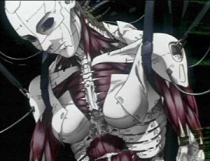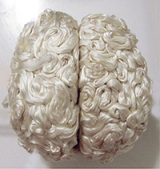Sarcology: Anatomy of a robot

from Ghost in the Shell
Robotics make up a major element of the novel Sarcology: Autos are self-driven, automated tools and homes abound, and the story revolves around a humanoid robot that is the subject of a blackmail scheme. Science fiction does love its robots. But it rarely goes into much detail about what goes into making its robots; words like “titanium” and “tronics” get thrown around, and occasionally a robot will have some part of its body opened up, to reveal flashy diodes and mechanical linkages. But the geek in you really wants to know: What’s really going on under the hood?
(Some of the details that follow are mentioned in the novel to an extent; but as the specific details are not germane to the story, they are largely glossed over or mentioned in passing. For those of you who crave more… enjoy.)
In Sarcology, the central robotic character is referred to as an S-sar—a Slaved Semi-Autonomous Robot—intended for dangerous duties like battlefield and high security postings. It is a prototype design, capable of being controlled remotely by a human operator—the “slaved” part of its name—or operating semi- or fully-autonomously as needed. It is designed to closely resemble a human being, including being relatively anatomically analogous to a human, though its skin color marks it as being artificial.
Sarcology means the study of the soft tissues of the body. In the story, scientists use the principles of sarcology to match or mimic biologic tissues with manufactured materials, and this starts at the s-sar’s skin. The texture and flexibility of the skin approximates human skin, albeit one with a protective film applied, giving it a slightly different sheen and texture, but a similar give. The overall effect makes it seem outwardly more like a high-quality mannequin than a stereotypical “robot.”
Its internal structure has a hardened skeleton, lighter and much stronger than human bone, with synthetic fibers attached at key points to do the work of a human’s musculature. The fibers contract upon receiving an electronic signal, just as human muscles contract upon receiving an electrochemical signal, but much faster and with more pulling power than human muscle. And this basic structure is sheathed by a durable yet flexible skin, capable of allowing some transfer of energy on demand, especially heat… yet also able to stop a bullet or other projectile.
All of the aforementioned parts are made possible thanks to a single substrate material: Graphene. A particular form of the highly-organized carbon chains collectively known as Buckminster Fullerenes, graphene is a linkable fullerene molecule that can be doped with many other molecules to give it increased strength, flexibility, conductivity, porosity, etc, as needed. Differently-doped forms of graphene make up 90% of the S-sar’s body and interior, providing excellent amalgams of human tissues.
The S-sar doesn’t need robotic versions of many of the organs in the human body; but it does require “organs,” or mechanisms, that approximate various of the most specialized parts of the body, such as the brain, the sensory organs, the heart and the nervous system.

Pablo Garcia Lopez
The most interesting of these mechanisms is certainly the Storage and Governing Processor, or SGP… the mechanism that takes over the duties of the human brain. The SPG also uses specialized graphene fibers, looking much like fine threads woven throughout the SGP structure, designed to function much like the nerve cells in the human brain, to transfer signals obtained from the sensory organs, organize them into associations that can be stored and recalled as needed, and send signals to the appropriate motors and systems to operate the body.
The SGP also incorporates a storage section optimized for direct digital storage and recall, allowing it to process automated signals from other digital devices. Its thread-like structure has the added advantage of being more durable than the more gelatinous form of the biological brain, making it more impervious to harm from external impacts. The SGP is capable of storing a significant portion of information analogous to human memory, backed by the digital storage and retrieval system, putting it on par with a human brain in many ways.
Devices like the eyes and ears are sealed, specially-designed components that are plugged into the interface to the SGP. The eyes are versatile camera systems, with a greater range of light reception than the human eye, being able to see significantly into the infrared and ultraviolet portions of the spectrum that the human eye cannot detect. It can also aid in the directional detection of radio waves, when combined with other sensory equipment laced through the S-sar’s body… it can “see” radio waves, to an extent. The eras are similarly more sensitive than those of the human body, and capable of selectively isolating certain sounds and frequencies for greater identification and distinction.
The S-sar has a sensory web embedded in its skin, capable of detecting pressure, heat, chemical changes and external vibrations. Much like the nervous system in the human body, it concentrates this web in its extremities and certain other areas that more often come into contact with foreign objects. These signals are channeled to a series of conduits that meet at a nexus housed at the S-sar’s upper torso, and run up into the SGP in two redundant channels, to ensure less loss of data. As data is transferred, nodes capture the data and send it wirelessly to the next operating node in the line, maintaining a connection even if a physical path is severed. In this way, the S-sar can continue to function even if it has been damaged beyond the point at which a human body could not function.
The S-sar’s “heart” is a miniaturized reactor that generates electricity through electrolysis. The S-sar carries on-board the chemicals it needs for that process, essentially, hydrogen and oxygen; but it can also extract both chemicals directly from the air, on demand, making the S-sar virtually impossible to run out of “fuel.”
Hinted at but not explored in the novel is the S-sar’s ability to alter the shape of its frame on demand. This feature is designed to allow the S-sar to resemble a particular person, as well as making subtle changes to its build or stature as required. As the S-sar also sports a “package” for primarily cosmetic purposes, this feature allows the penis to alter in size and shape as required… a feature which, as it happens, does come in handy in the story.
When these elements are combined, they result in a mechanical system that is in many ways superior to the human organism: Stronger, faster, more resilient, and capable of superior memory and retention in certain areas. It does not match the human body; and in Sarcology, the central S-sar is a prototype, whose functions and capabilities have not yet been fully evaluated.





